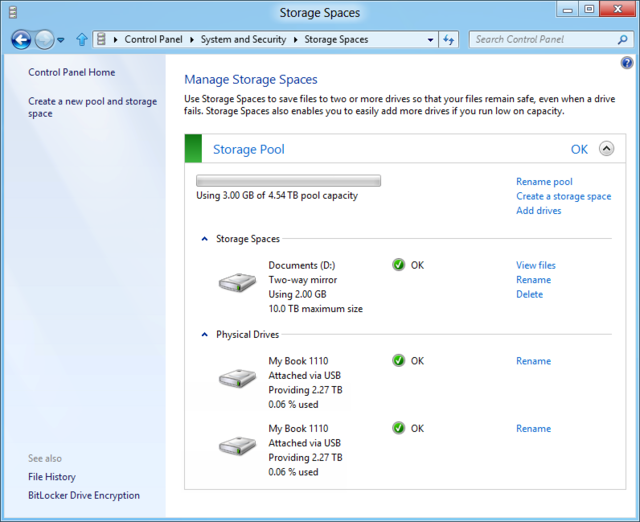
When Microsoft killed Windows Home Server's "Drive Extender" technology, we mourned its loss but held up hope that the company would persevere with the concept. The company has done just that with a new Windows 8 feature called Storage Spaces, described in a lengthy post to its Building Windows 8 blog.
With Storage Spaces, physical disks are grouped together into pools, and pools are then carved up into spaces, which are formatted with a regular filesystem and are used day-to-day just like regular disks.
Unlike RAID systems of old, but in common with other modern storage technologies such as Solaris' ZFS and Linux's btrfs, pools can use disks of different interface technologies—USB, SATA, Serial Attached SCSI—and different, mismatched sizes. New disks can be added to a pool at any time. Pools can also include one or more hot spares: drives allocated to a pool but kept in standby until another disk in the pool fails, at which point they spring into life.
Storage in a pool is then distributed among one or more spaces. Each space can have its own redundancy policy, with three kinds of fault tolerance offered: 2-way mirroring, 3-way mirroring, and RAID 5-like parity. With the mirrored options, a space's data is stored either twice or three times within a pool. With the parity option, the system will compute additional information and store this within the pool. If any disk in the pool fails, the data can be reconstructed using this additional information.
Spaces can be thinly provisioned, allowing the creation of spaces that are larger than the underlying pool. This allows potentially simpler management—a large "media" space for TV shows and movies could be created with some large size, say 50 TB, with only 2 TB of physical capacity in the pool. As more shows are recorded or downloaded, and space becomes tighter, additional drives can be added to the pool; the space will then use this extra capacity with no further configuration required.
The new technology appears to be superior to Windows Home Server's Drive Extender technology in just about every regard, and its integration into the core operating system indicates that it's robust enough for mainstream usage. The blog post implies that Storage Spaces are ready even for enterprise workloads, making mention of the ability to scale up to "very large-scale enterprise datacenter[s]", with pools made up of "hundreds of disks"—not a promise anyone would make of the home user-oriented Drive Extender.
Perhaps the only fly in the ointment for most home users is that in Windows 8, Storage Spaces will not be bootable. The company says that guidance will be offered on how to partition disks so that a partitioned boot disk can be added to a pool, but that straightforward booting unfortunately won't be possible. On some levels, this is unsurprising: many advanced filesystem and storage systems are not bootable in their initial version, and Storage Spaces certainly won't be the first. On the other, it would certainly be a desirable addition, as it would ensure that even if a boot disk failed, your PC would remain operational.
The first mention of Storage Spaces were made at Microsoft's BUILD conference in September 2011. At BUILD, the company did not offer significant details about the technology, and spoke of it in relation to Windows Server 8. Judging by the nature of the usage scenarios outlined in the blog post—storing videos and photographs, using USB external disks—it appears that Storage Spaces will be a feature of the desktop operating system too. We've asked Microsoft for clarification on this point.
Update: As expected, Storage Spaces will indeed be a feature of both desktop and server editions of the operating system.
If the feature does indeed ship in desktop Windows, it will overnight obsolete a range of SOHO-oriented storage systems; products like Drobo and ReadyNAS will find it hard to survive in a Windows 8 world.
Listing image by Image courtesy of Microsoft
reader comments
196